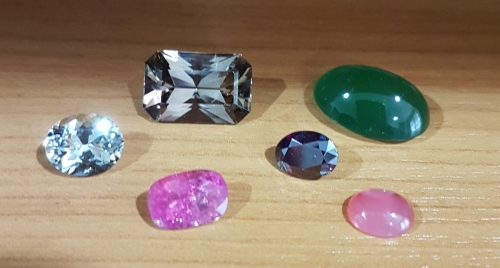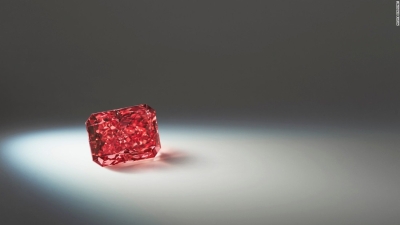 |
| Oligoclase, Pezzottaite, Barite, Cuprite, Williamsite and Rhodochrosite |
We supply rare stones to fine jewelers and collectors around the world, including Burma ruby, Ceylon sapphire and the finest spinel, topaz and garnet. But in recent years we've seen a growing interest in rare and unusual, even obscure, gem varieties.
Gem collectors have always sought out the finest specimens, with an eye for stones that are likely to appreciate in value over time. Strictly speaking, all gem-quality minerals are rare. That is because only a tiny fraction of the minerals found in the earth are sufficiently transparent and clean to be called gemstones.
But within the world of gem-quality stones, some gems are relatively common and inexpensive. These are the stones you will find set in low-cost commercial jewelry, such as blue topaz, pyrope and almandine garnet, onxy and lower grade amethyst, citrine and peridot.
On the other hand, there are certain gems which count as especially rare and are sought after by collectors and museums. These rare gems fall into two main categories. Some gems belong to rare varieties, where only a small number of specimens are known to exist. Any high quality specimen would count as rare. Then there are rare individual gems, distinguished by their exceptional color, clarity and size. Almost every gem variety has some especially rare specimens.
 |
 |
 |
| Taaffeite Sri Lanka |
Kornerupine Tanzania |
Sphalerite Spain |
The rarest varieties tend to be obscure and virtually unknown to the general public. They include unusual gems like benitoite, jeremejevite, grandidierite, cobaltocalcite, cuprite, oligoclase and pezzottaite. These are gems for the dedicated collector and are only occasionally set in jewelry.
You'll find that we have significantly expanded our collection of rare varieties and we continue to specialize in rare gems for collectors. You'll find an index on our home page in the Rare Gem Varieties section, and some notable examples in this month's newsletter.
Notable Gems from the Just Color Collection
This month we feature some rare collector gems from our collection, including a very rare Benitoite that we've just acquired.
Click on a photo to see the details for the item.
News from Just Color and the Gems World
Rio Tinto Previews 2.11 ct Red Diamond in NY

Rio Tinto has unveiled the largest Fancy Red diamond ever discovered in Australia. The 2.11 carat polished radiant cut diamond, known as The Argyle Everglow, is the centrepiece of the 2017 Argyle Pink Diamonds Tender – an annual showcase of the rarest diamonds from Rio Tinto’s Argyle mine. The diamond has been graded by GIA as a Fancy Red VVS2. Red diamonds are the rarest of all colored gems, with most known specimens under 1 carat.
The Argyle mine in Western Australia is the world's biggest diamond mine based on the number of carats produced -- more than 800 million carats since mining began in 1983. Though most of the diamonds produced by Argyle are lower value brown diamonds, the mine is known for some ultra-rare pink, purple, violet, red, and blue diamonds. Indeed, the Argyle mine produces 90% of the world's rare pink diamonds.
The Argyle mine is scheduled to close in 2021 so it is unlikely that another diamond as rare as the 2.11 ct Fancy Red will be found there again.
Ask the Gem Experts
Each month we answer questions from our customers. We welcome your questions and you can submit a question from our contact page.
How do you ensure your madagascan sapphires are mined ethically, without
damage to the environment? DC, UK
Sapphire mining in Madagascar is artisanal, carried out by independent miners with pick and shovel. There is hardly any mechanized mining, since the mines are mostly in remote areas inaccessible by road. Much of the mining is recovering alluvial sapphire by sifting gravel in riverbeds. The Malagasy government does not permit mining in the national parks (10% of Madagascar's land area is now protected national parks, including the environmentally sensitive rainforests). So in principle the environmental impact of sapphire mining should be relatively slight.
Having said, there have been some incidents of a gemstone rush reminiscent of the California gold rush in 1849. In November 2016 there was an important find of sapphire and ruby near the town of Didy in northeastern Madagascar. More than 45,000 miners rushed to the area, which is in a protected rainforest. For a few months the government was unable to control unregulated mining before soldiers moved the miners out. This pattern has been repeated several times in the history of Madagascar gem mining.
From an ethical point of view, gemstone mining is an important source of income for hundreds of thousands of people in Madagascar. According to UNICEF, 81.3% of the people in Madagascar earn below the international poverty line of USD $1.25 per day. So the Malagasy government and international NGO's are trying to find a way to balance economic development and conservation.
All the best in gems,
Arnold, Rung & Ron





